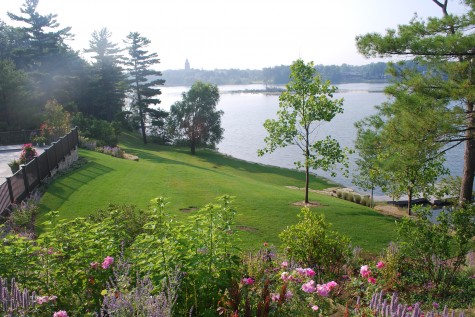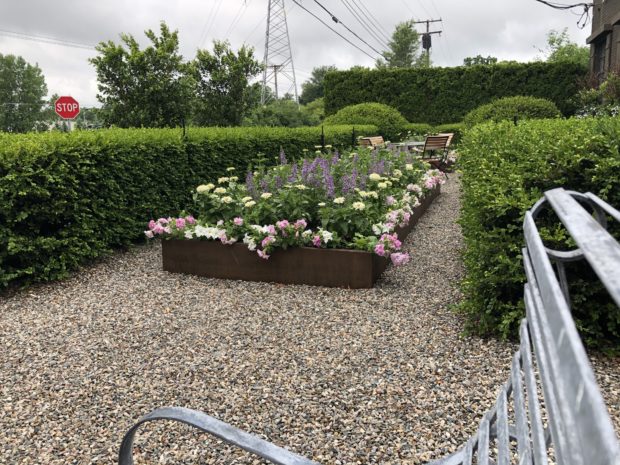 Planting the summer garden in front of the shop this year was more about less than anything. Every supplier of seasonal plants was inundated with customers from the very first hint of spring. Plants I had custom grown, labelled sold, and roped off for gardens to be planted in June were a constant target of gardeners anxious to provide both beauty and interest to their outdoor spaces early in May. My plants needed feeding, watering, and a watchful eye. My grower sold through his entire June crop in May. He was not the only one. Astonishing, this. No wonder my stock of reserved plants looked inviting. I am not a fan of planting tropical plants in cold soil. But choosing to wait to plant had consequences. Needless to say, we were scrambling for material the entire month of June, and July was even worse. By the time all of our client’s work was complete, it was well in to July. So we planted the front gardens with what was left from what we had custom grown. Several varieties of white zinnias and angelonia “Steel Blue” would just about fill these steel raised planter boxes.
Planting the summer garden in front of the shop this year was more about less than anything. Every supplier of seasonal plants was inundated with customers from the very first hint of spring. Plants I had custom grown, labelled sold, and roped off for gardens to be planted in June were a constant target of gardeners anxious to provide both beauty and interest to their outdoor spaces early in May. My plants needed feeding, watering, and a watchful eye. My grower sold through his entire June crop in May. He was not the only one. Astonishing, this. No wonder my stock of reserved plants looked inviting. I am not a fan of planting tropical plants in cold soil. But choosing to wait to plant had consequences. Needless to say, we were scrambling for material the entire month of June, and July was even worse. By the time all of our client’s work was complete, it was well in to July. So we planted the front gardens with what was left from what we had custom grown. Several varieties of white zinnias and angelonia “Steel Blue” would just about fill these steel raised planter boxes.
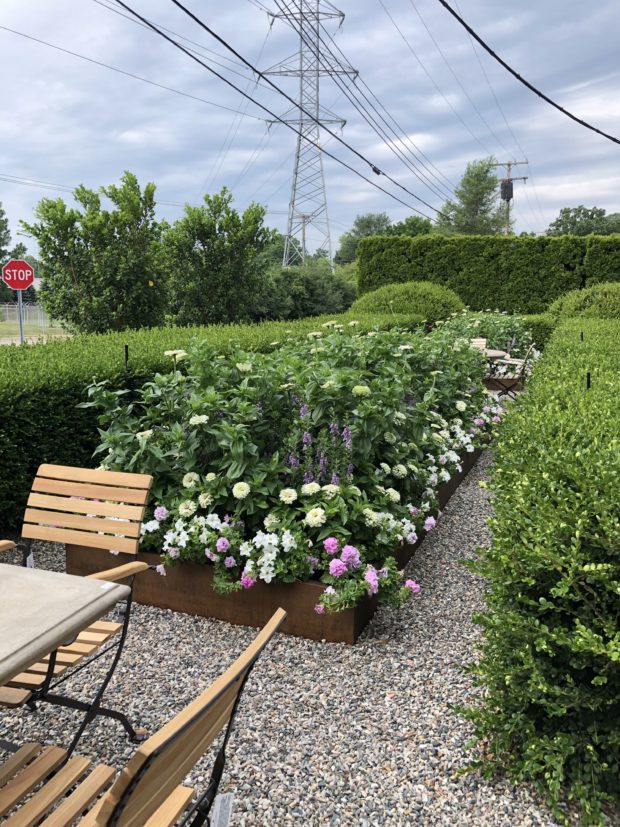 For the border, we managed to find some white petunias, and mixed them with the double pink cascade grandiflora petunia “Orchid Mist” – also custom grown for us. Those frilly petunia puffs are reminiscent of the tissue paper flowers made for homecoming floats in the 60’s. Given that association, it’s easy to see why those plants had not been snapped up sooner. Their habit of growth is awkward, lanky, and lax. The dead flowers persist on the plants for a long time. In spite of their shortcomings, I like double petunias. Every seasonal plant has their place in the sun. Paired with a stiff growing plant that can provide structure and support, double petunias in pink or white can be plenty gorgeous.
For the border, we managed to find some white petunias, and mixed them with the double pink cascade grandiflora petunia “Orchid Mist” – also custom grown for us. Those frilly petunia puffs are reminiscent of the tissue paper flowers made for homecoming floats in the 60’s. Given that association, it’s easy to see why those plants had not been snapped up sooner. Their habit of growth is awkward, lanky, and lax. The dead flowers persist on the plants for a long time. In spite of their shortcomings, I like double petunias. Every seasonal plant has their place in the sun. Paired with a stiff growing plant that can provide structure and support, double petunias in pink or white can be plenty gorgeous.
 It was not surprising that we still had tall growing zinnias available in June. They cannot be planted too early in the greenhouse, as once the seed germinates, they grow fast. Timing crops to be ready when the weather permits and people want to shop is the black art of the greenhouse growing business. No planting crew wants to haul annuals to a jobsite that are 2′ tall in a four inch pot. I want my zinnias short and stocky. So the large growing zinnias were not available until later in the planting season. Few gardeners have the self discipline to delay planting a summer container until the zinnias are available. Who would risk it, knowing the other plants to go with might be sold out by then. I am familiar with this logistical problem. If zinnias are well grown, and at a perfect stage to transplant, they are green. Meaning the plants are not in flower. A bench full of zinnias is an ocean of green leaves. If you are looking for a particular color, you have to read the tags. All these things work against the zinnias flying out the door. It is not really a May-ready plant.
It was not surprising that we still had tall growing zinnias available in June. They cannot be planted too early in the greenhouse, as once the seed germinates, they grow fast. Timing crops to be ready when the weather permits and people want to shop is the black art of the greenhouse growing business. No planting crew wants to haul annuals to a jobsite that are 2′ tall in a four inch pot. I want my zinnias short and stocky. So the large growing zinnias were not available until later in the planting season. Few gardeners have the self discipline to delay planting a summer container until the zinnias are available. Who would risk it, knowing the other plants to go with might be sold out by then. I am familiar with this logistical problem. If zinnias are well grown, and at a perfect stage to transplant, they are green. Meaning the plants are not in flower. A bench full of zinnias is an ocean of green leaves. If you are looking for a particular color, you have to read the tags. All these things work against the zinnias flying out the door. It is not really a May-ready plant.
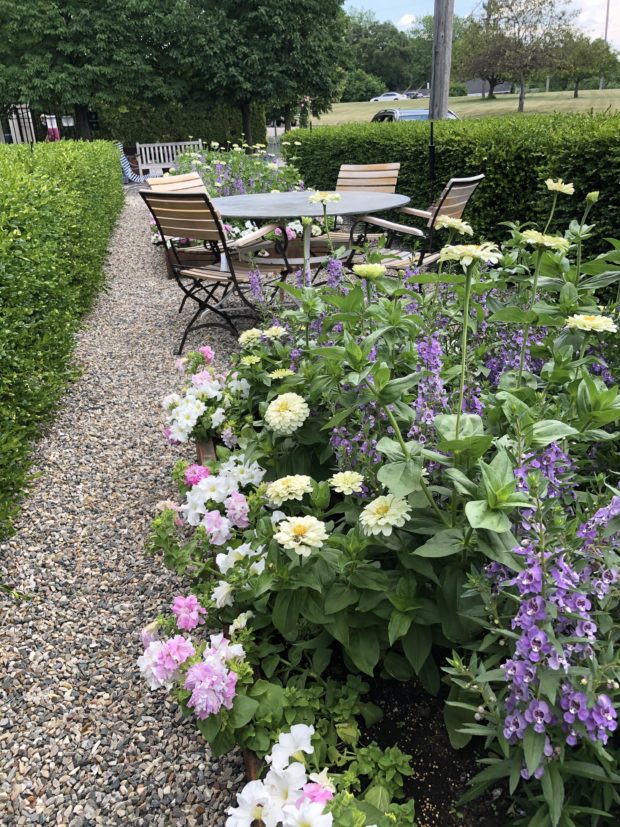 For as simple as the big flowered tall zinnias are to germinate from seed and grow, they are heir to no end of troubles. If you are interested, see the following from the Handbook of Florist’s Crops diseases, pages 1-31. common fungal and bacterial diseases of zinnias Some growers want no part of this trouble, and chose to grow only disease resistant varieties such as the Profusion series. Gardeners don’t care for high maintenance annuals either. Lisa M, who does a terrific job of maintaining our seasonal plants and anything that grows on the shop property, prunes selectively to improve air circulation, squishes the sucking insects (notably grasshoppers) that transmit virus and disease via their chewing, and removes any leaves that show signs of bacterial leaf spot – and so on.
For as simple as the big flowered tall zinnias are to germinate from seed and grow, they are heir to no end of troubles. If you are interested, see the following from the Handbook of Florist’s Crops diseases, pages 1-31. common fungal and bacterial diseases of zinnias Some growers want no part of this trouble, and chose to grow only disease resistant varieties such as the Profusion series. Gardeners don’t care for high maintenance annuals either. Lisa M, who does a terrific job of maintaining our seasonal plants and anything that grows on the shop property, prunes selectively to improve air circulation, squishes the sucking insects (notably grasshoppers) that transmit virus and disease via their chewing, and removes any leaves that show signs of bacterial leaf spot – and so on.
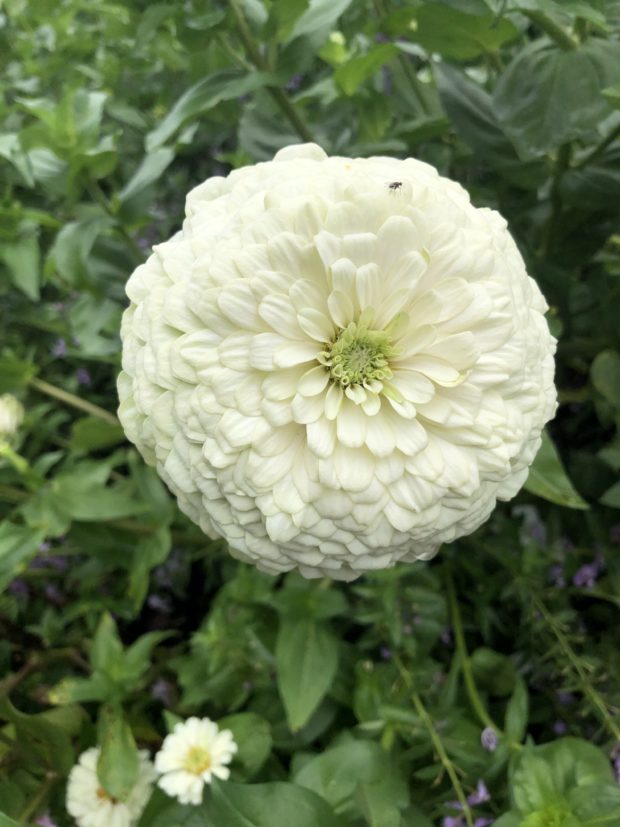 A well grown zinnia is a sure sign of high summer in the cutting garden. They don’t call the medium height zinnias “cut and come again” for nothing. They last impossibly long as cut flowers. Floret Flowers grows them by the semi truck load for the cut flower trade. Floret Flowers They come in just about every color imaginable, except for blue. They are old fashioned flowers, for sure. It is the one flower I can distinctly remember from my Mother’s garden some 60 years ago. Yes, the dahlia flowered varieties have a stiff and awkward look about them, but how I love their down to earth cheer and charm.
A well grown zinnia is a sure sign of high summer in the cutting garden. They don’t call the medium height zinnias “cut and come again” for nothing. They last impossibly long as cut flowers. Floret Flowers grows them by the semi truck load for the cut flower trade. Floret Flowers They come in just about every color imaginable, except for blue. They are old fashioned flowers, for sure. It is the one flower I can distinctly remember from my Mother’s garden some 60 years ago. Yes, the dahlia flowered varieties have a stiff and awkward look about them, but how I love their down to earth cheer and charm.
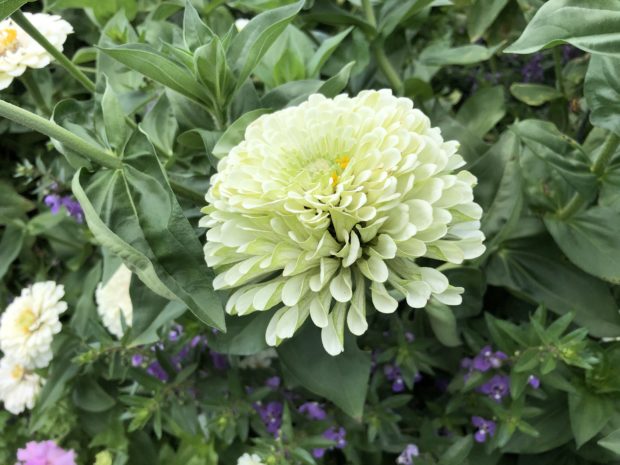 They are not at all showy like roses, dahlias, foxglove, peonies, delphiniums or orchids. They look most at home with the daisies, sunflowers, feverfew and cosmos. The kitchen garden is an ideal place for them. It is tough to plant them meadow style with other looser growing seasonal plants in my zone, as they resent close quarters. Once you are not able to reach them to clean them up, the leaf spot, mildew and other mayhem will start to consume them. Someday I will try them with amni majus, Gaura lindheimeri, or the grass Bouteloua gracilis “Blonde Ambition”. The angelonia is a pretty decent partner. I would do that again.
They are not at all showy like roses, dahlias, foxglove, peonies, delphiniums or orchids. They look most at home with the daisies, sunflowers, feverfew and cosmos. The kitchen garden is an ideal place for them. It is tough to plant them meadow style with other looser growing seasonal plants in my zone, as they resent close quarters. Once you are not able to reach them to clean them up, the leaf spot, mildew and other mayhem will start to consume them. Someday I will try them with amni majus, Gaura lindheimeri, or the grass Bouteloua gracilis “Blonde Ambition”. The angelonia is a pretty decent partner. I would do that again.
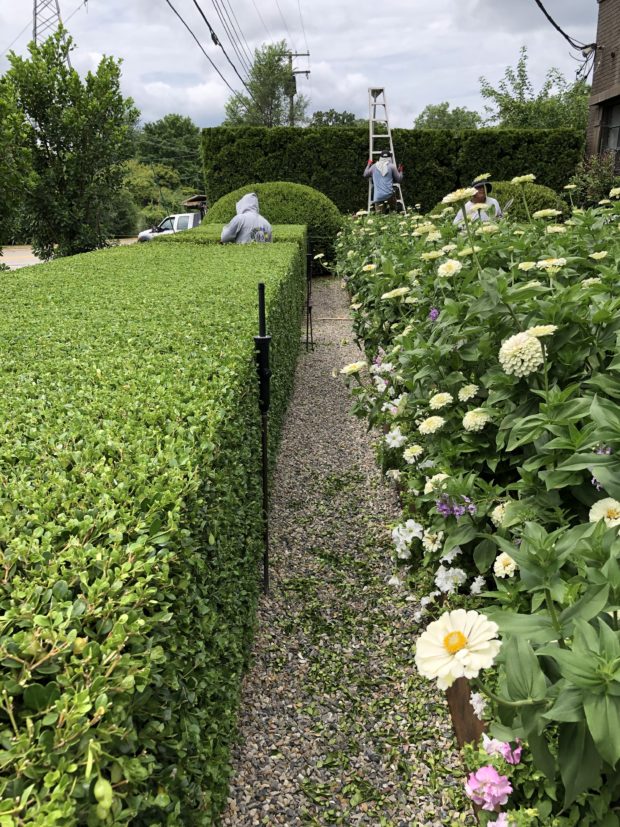 A few weeks ago, the boxwood in front of the shop got their yearly haircut. The precision with which this is done is astonishing. M’s crew is a gifted lot, with an impeccable instinct for up and down, true and square. It’s as if the horizon line is embedded in their genes. The geometry of the boxwood is in sharp contrast to the zinnias. Only a deftly pruned hedge of boxwood could make a planting of zinnias look graceful.
A few weeks ago, the boxwood in front of the shop got their yearly haircut. The precision with which this is done is astonishing. M’s crew is a gifted lot, with an impeccable instinct for up and down, true and square. It’s as if the horizon line is embedded in their genes. The geometry of the boxwood is in sharp contrast to the zinnias. Only a deftly pruned hedge of boxwood could make a planting of zinnias look graceful.
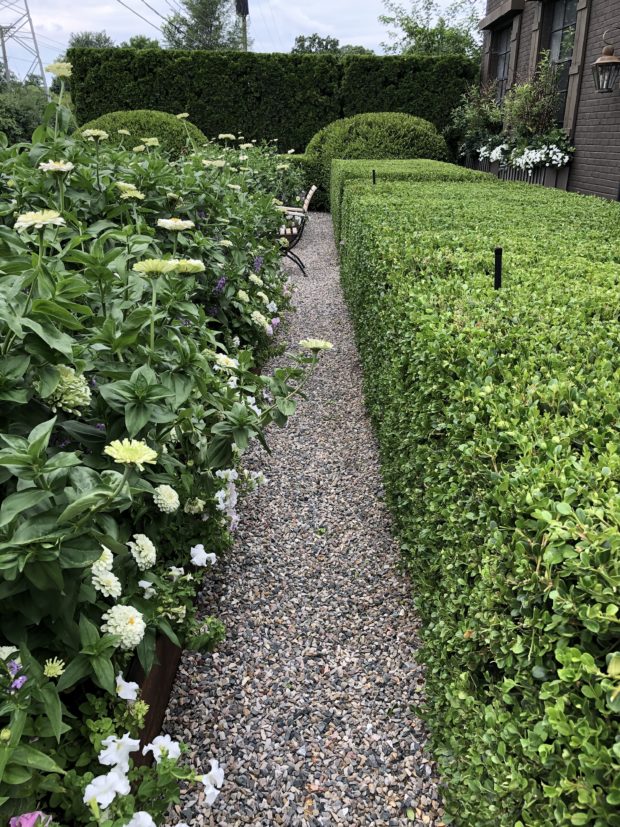 But the real purpose of this post is about the weather. This year has been very hot and dry. Overall, the humidity has been low. Perfect conditions for growing great zinnias. Perfect conditions for growing all manner of seasonal plants that revel in dry heat. People may be wilting, but the seasonal flowers are very good looking this year. If you happened to plant some zinnias, that planting is exceptional right now. As no gardener has any control over the weather, the big idea here is about spending some time with the National Weather Service about their prediction for the summer in your zone, ahead of choosing what you will plant. The perfect time to grow zinnias is when a summer season will be perfect for growing them. If weather predicting sounds too tedious, then plant lots of everything. You are bound to hit the jackpot with something.
But the real purpose of this post is about the weather. This year has been very hot and dry. Overall, the humidity has been low. Perfect conditions for growing great zinnias. Perfect conditions for growing all manner of seasonal plants that revel in dry heat. People may be wilting, but the seasonal flowers are very good looking this year. If you happened to plant some zinnias, that planting is exceptional right now. As no gardener has any control over the weather, the big idea here is about spending some time with the National Weather Service about their prediction for the summer in your zone, ahead of choosing what you will plant. The perfect time to grow zinnias is when a summer season will be perfect for growing them. If weather predicting sounds too tedious, then plant lots of everything. You are bound to hit the jackpot with something.
 Those good years for crocus,magnolias, roses and hydrangeas are memorable. Memorable, as no gardener can count on a good year coming their way. All the terrible years for zinnias do not deter me from planting them. But this year, it was just about all I had available to plant. I do not think of the natural world as being the least bit just. This year I got lucky.
Those good years for crocus,magnolias, roses and hydrangeas are memorable. Memorable, as no gardener can count on a good year coming their way. All the terrible years for zinnias do not deter me from planting them. But this year, it was just about all I had available to plant. I do not think of the natural world as being the least bit just. This year I got lucky.  lime and yellow zinnias
lime and yellow zinnias
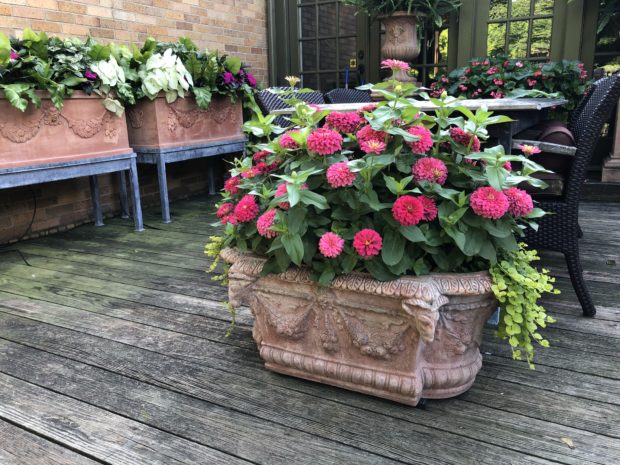 Pot full of zinnia “Zesty Fuchsia”
Pot full of zinnia “Zesty Fuchsia”
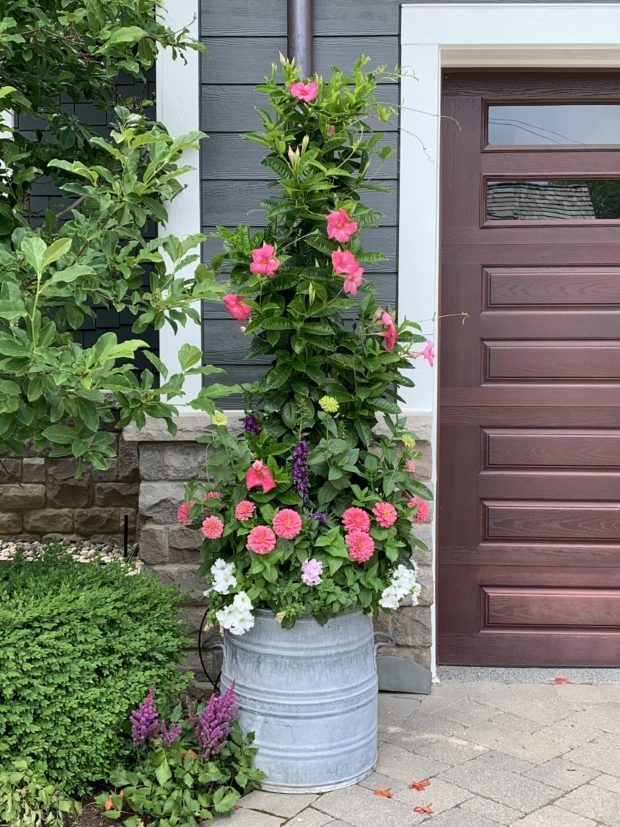 Container featuring zinnia Magellan pink
Container featuring zinnia Magellan pink
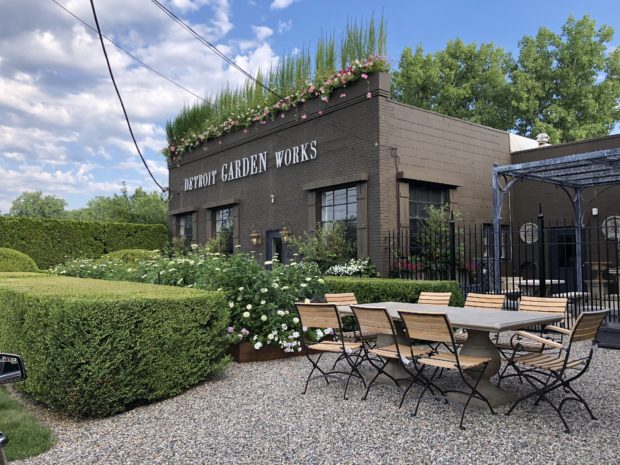 If for no other reason, stop in to see the zinnias. They are quite something this year.
If for no other reason, stop in to see the zinnias. They are quite something this year.
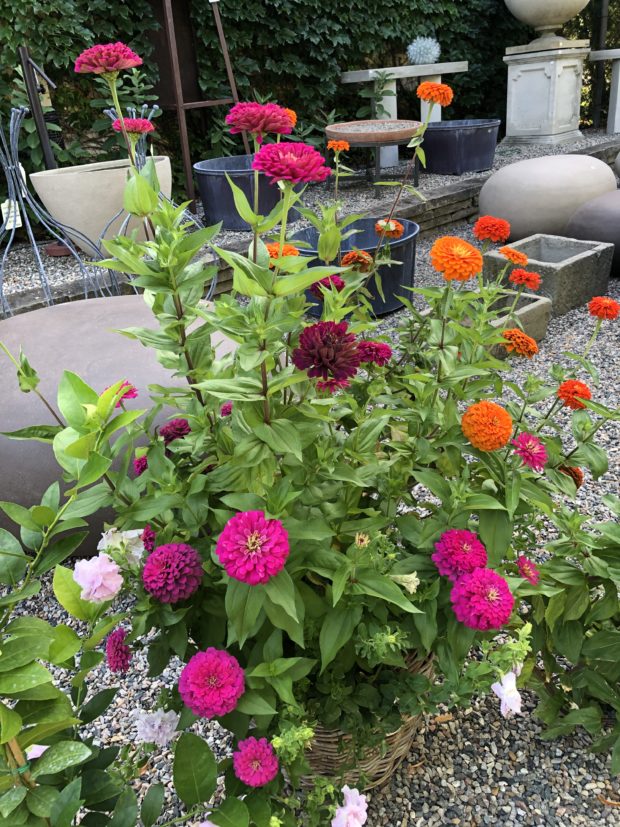
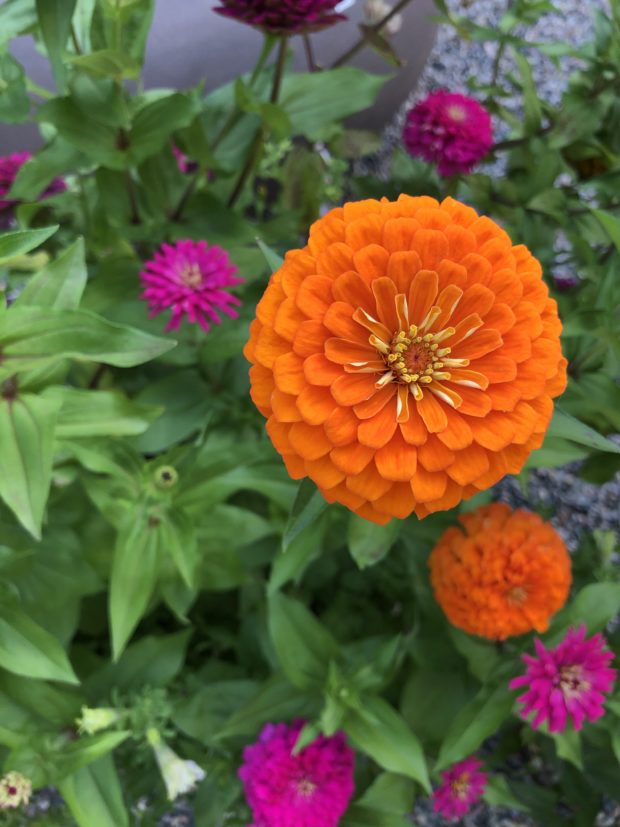
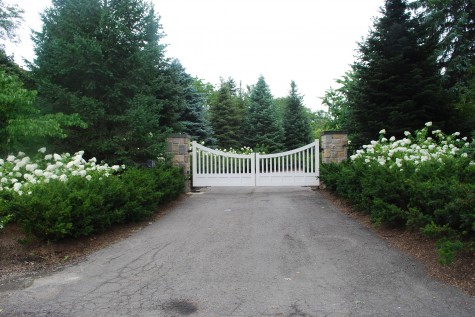
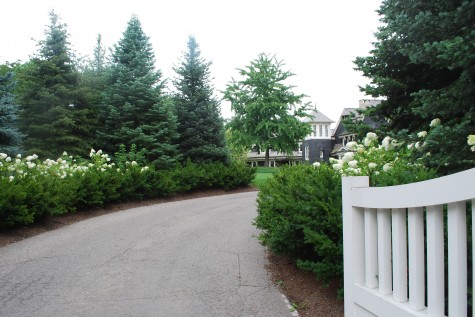 The entrance to the property has a beautiful view-in large part sparked by my client. Designers who do not listen to their clients miss plenty. I did design the drive especially to court the view; my client went over this plan again and again, until we both were happy with it.
The entrance to the property has a beautiful view-in large part sparked by my client. Designers who do not listen to their clients miss plenty. I did design the drive especially to court the view; my client went over this plan again and again, until we both were happy with it.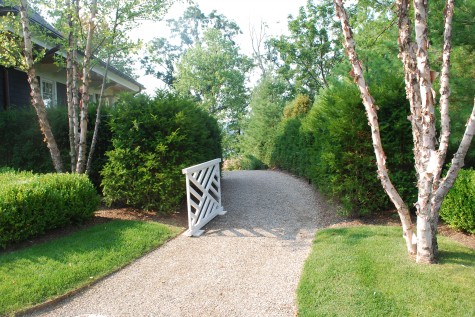 A decomposed granite walk leads to the rear yard; the gate is still in the design phase. A good walk intrigues a visitor. Vis a vis the curves in this walk-what need is there to telegraph every move a landscape makes from the start? A well designed walk anticipates interest, before the landscape delivers.
A decomposed granite walk leads to the rear yard; the gate is still in the design phase. A good walk intrigues a visitor. Vis a vis the curves in this walk-what need is there to telegraph every move a landscape makes from the start? A well designed walk anticipates interest, before the landscape delivers. 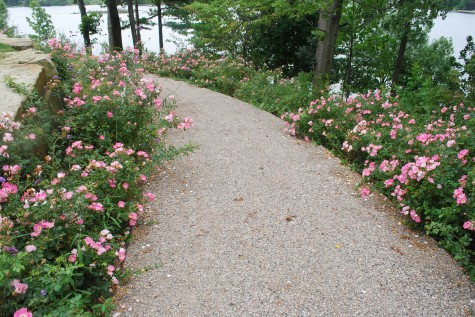 This long walk to the rear is fringed by the Griffith Buck rose, Carefree Delight. No kidding, a carefree wonder. This rose blooms and grows profusely, with little or no disease, in full sun, or part shade. This hedge performs equally, in spite of differing sun conditions, and fierce winter winds off the lake. I know a planting of them near me done by a friend-some 12 years old. Gorgeous. Carefree Beauty is my favorite rose; Carefree Delight delivers spectacularly; it is everblooming, adaptable to less than optimal siting, and happy to boot.
This long walk to the rear is fringed by the Griffith Buck rose, Carefree Delight. No kidding, a carefree wonder. This rose blooms and grows profusely, with little or no disease, in full sun, or part shade. This hedge performs equally, in spite of differing sun conditions, and fierce winter winds off the lake. I know a planting of them near me done by a friend-some 12 years old. Gorgeous. Carefree Beauty is my favorite rose; Carefree Delight delivers spectacularly; it is everblooming, adaptable to less than optimal siting, and happy to boot.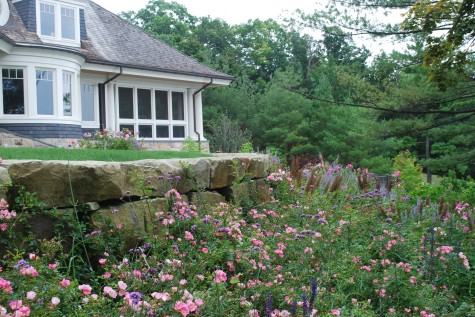
 This wild summer garden is in remarkable contrast to the architecture of the house. It is, to my mind, a successful relationship. At the risk of repeating myself, I think the dynamics of a relationship far outweigh this part, or that part-taken individually.
This wild summer garden is in remarkable contrast to the architecture of the house. It is, to my mind, a successful relationship. At the risk of repeating myself, I think the dynamics of a relationship far outweigh this part, or that part-taken individually. 